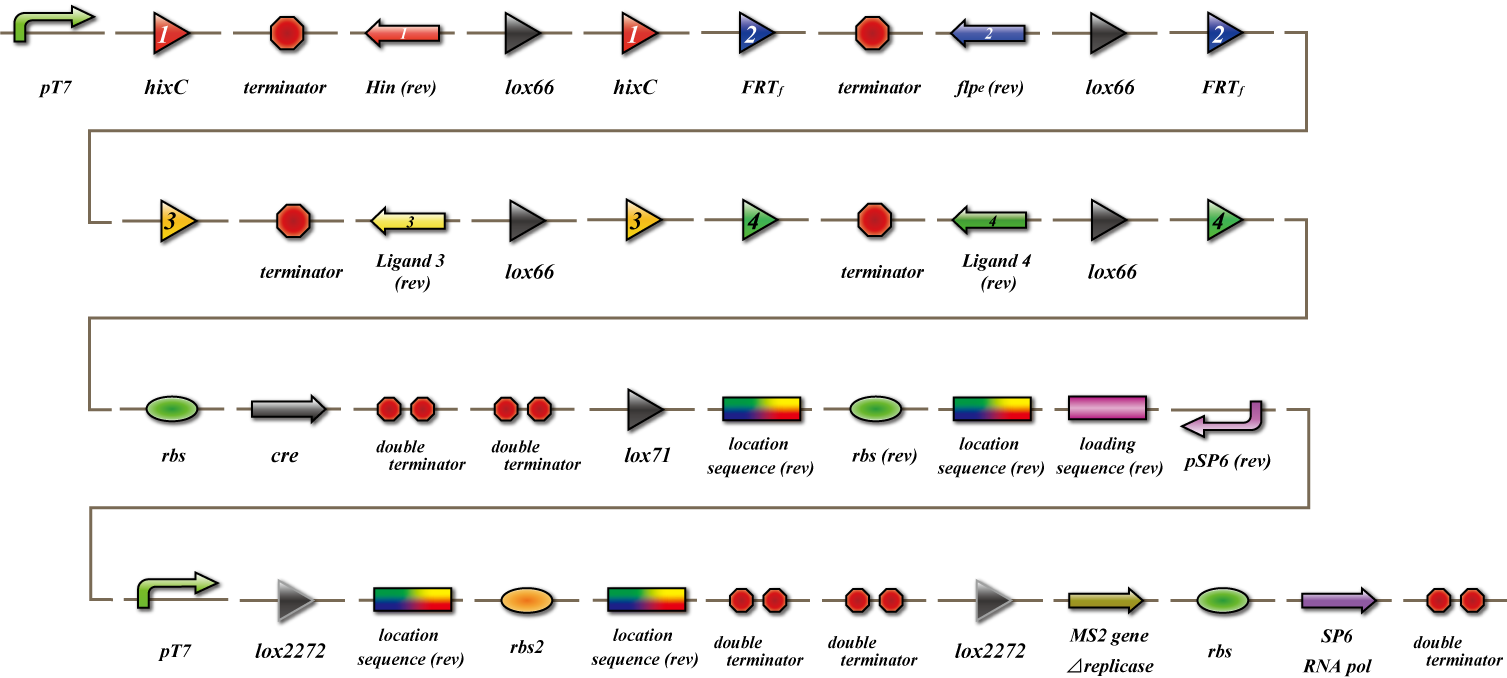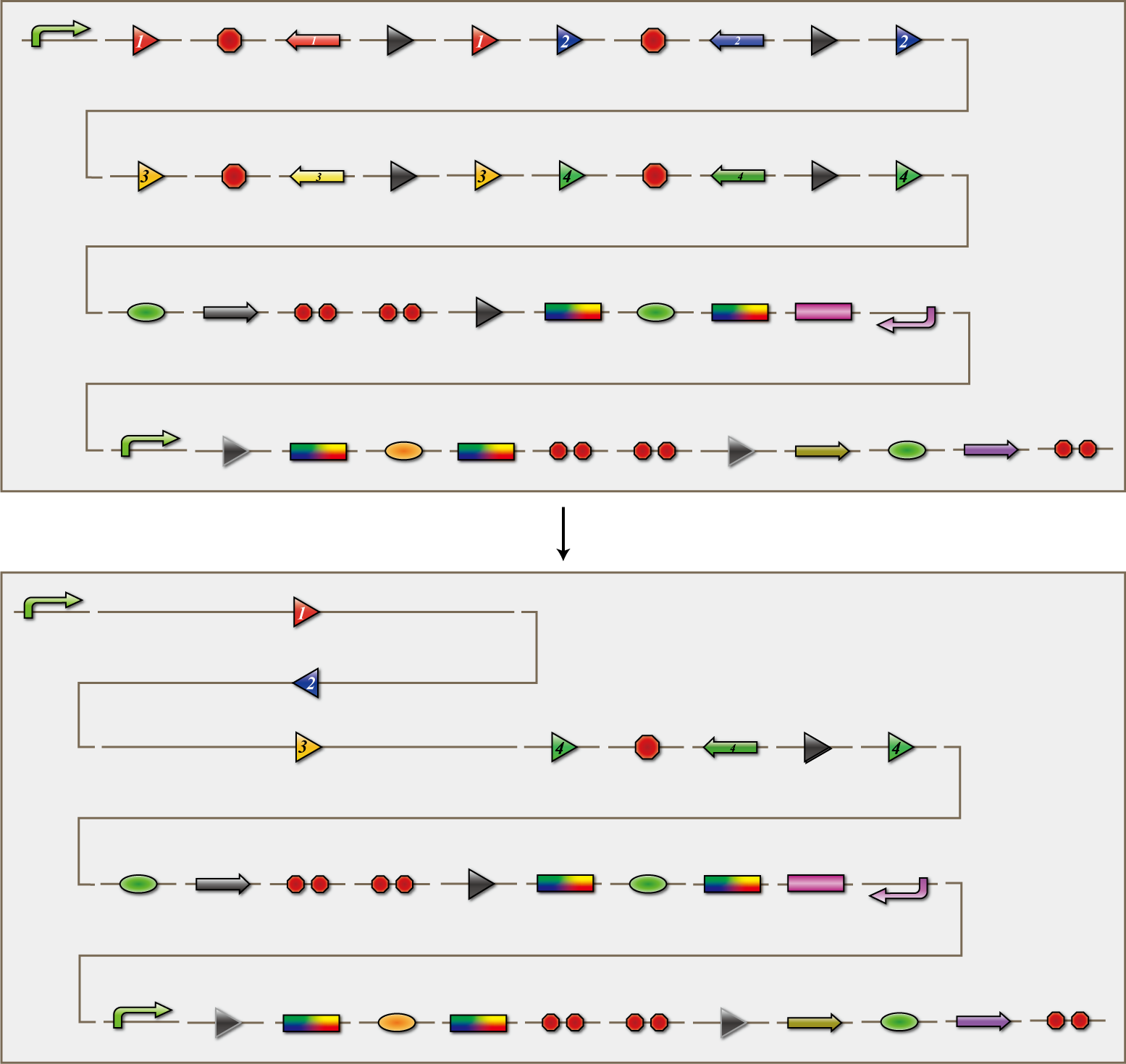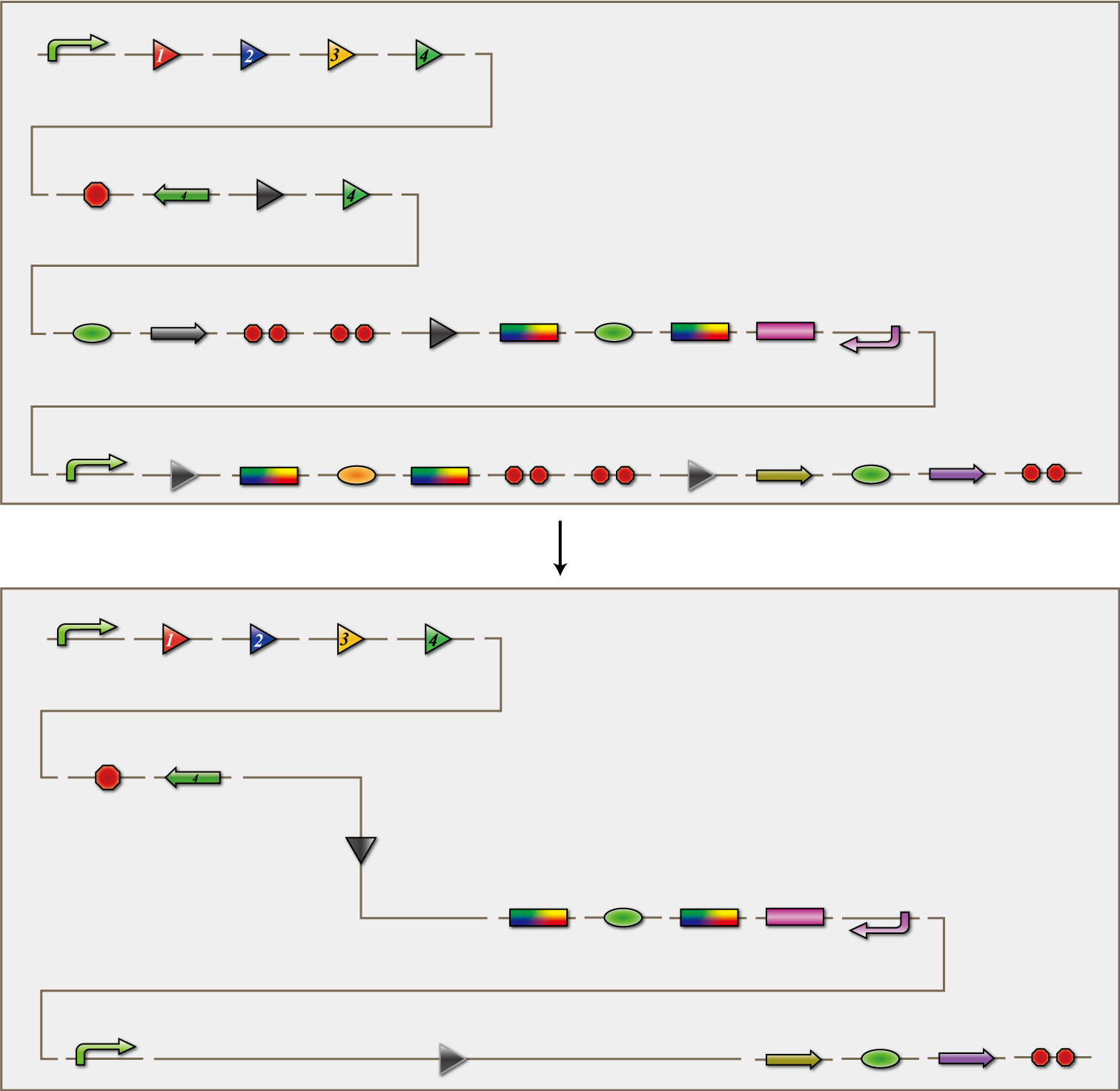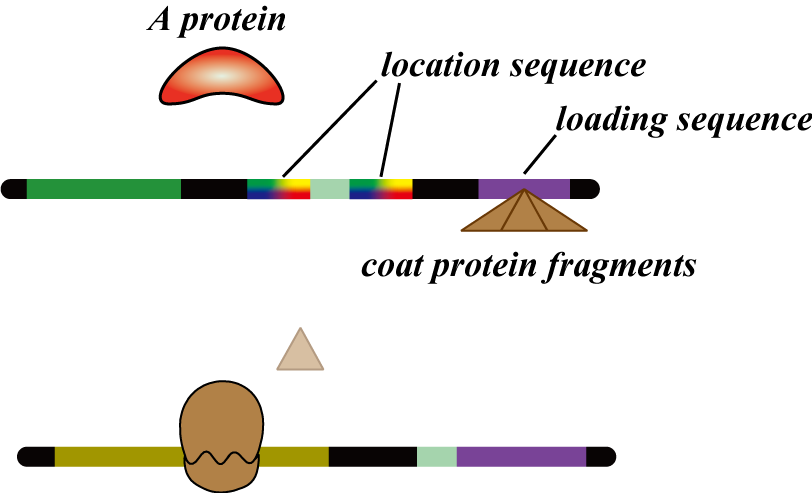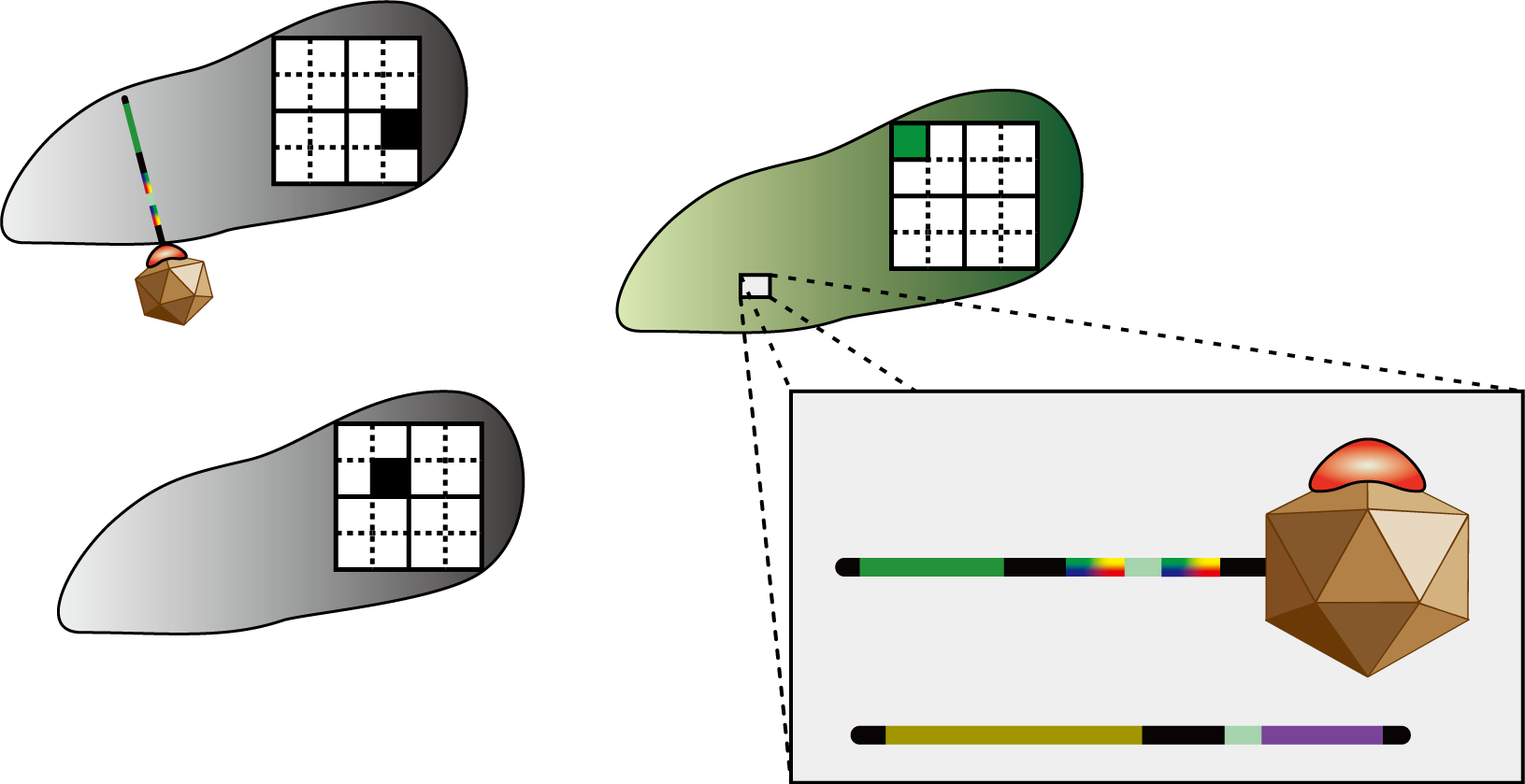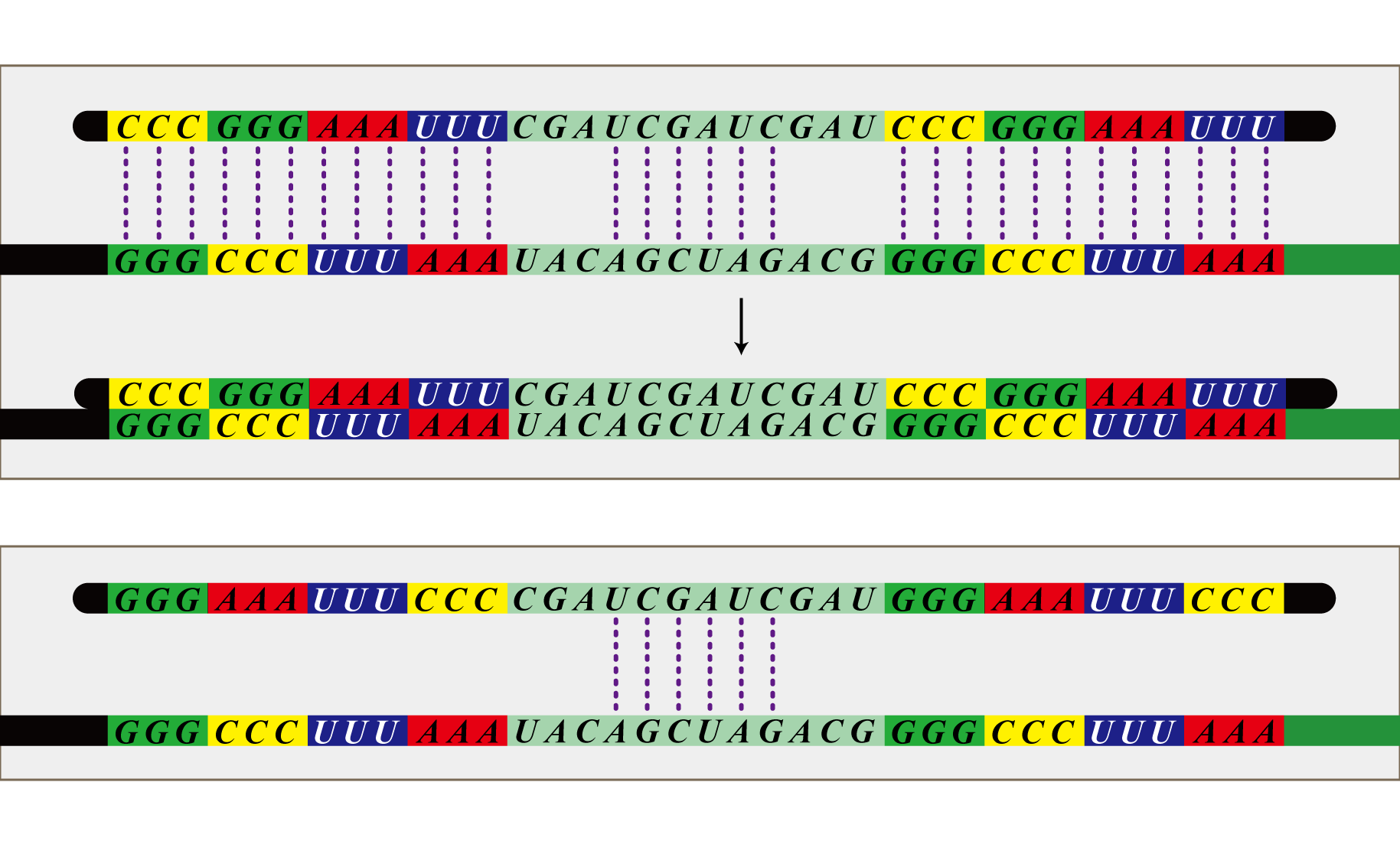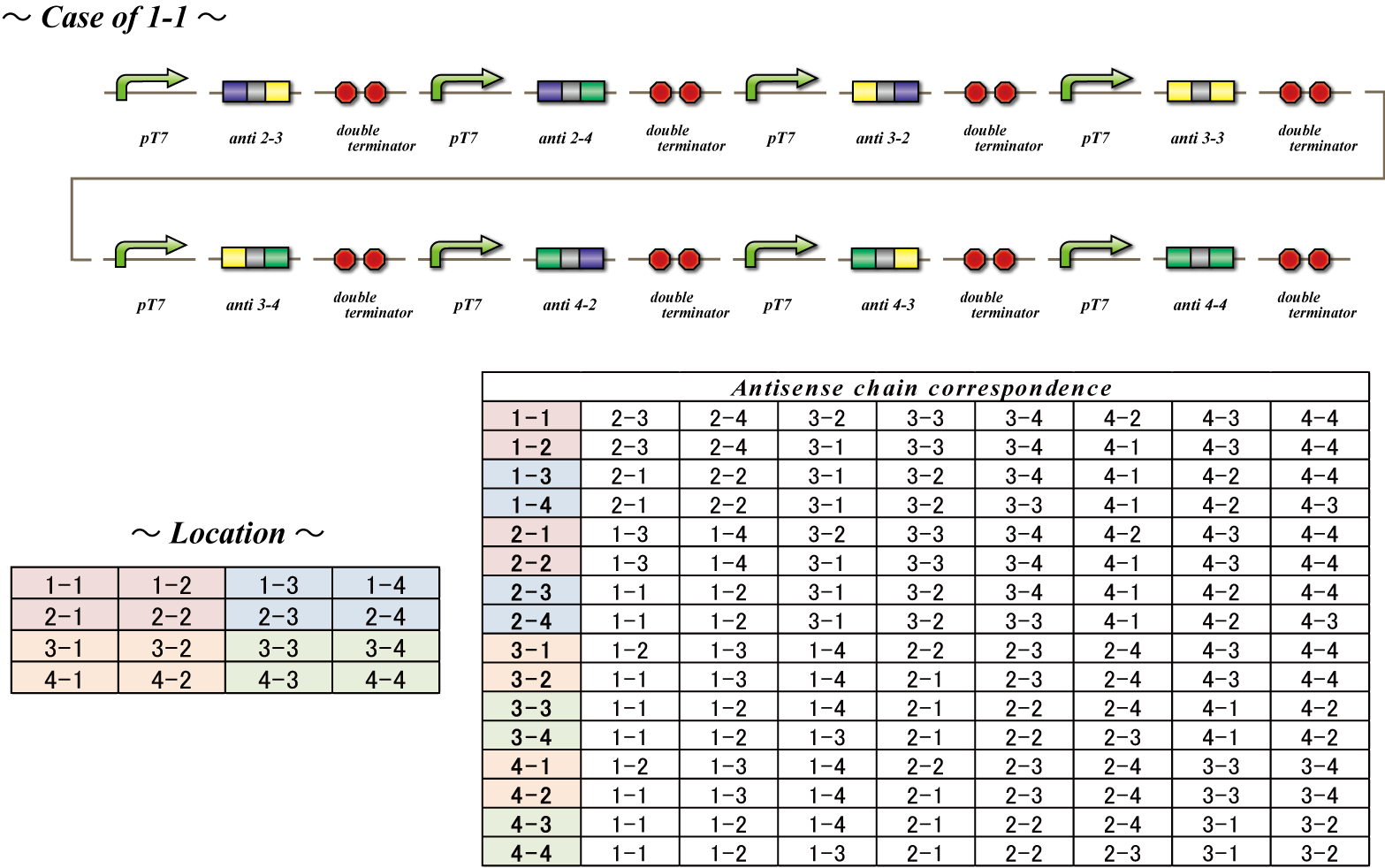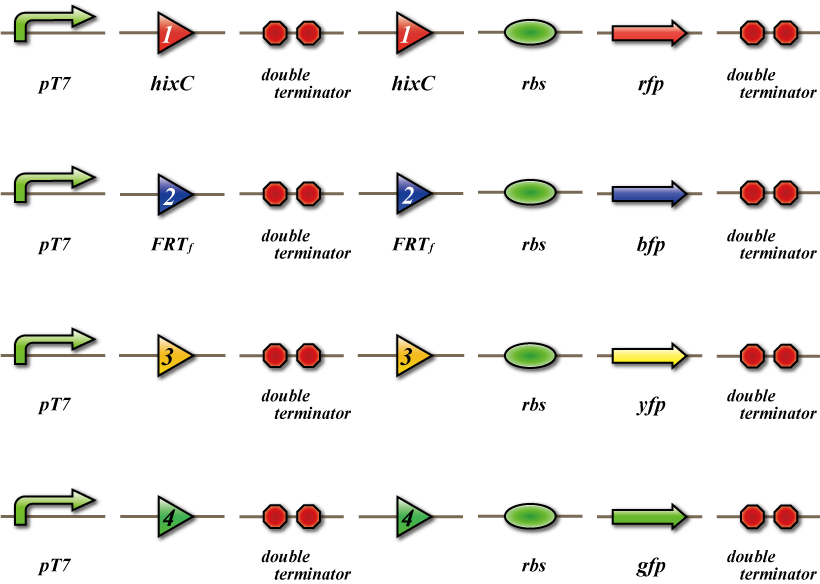Team:UT-Tokyo/Sudoku construct
From 2010.igem.org
(→4C3 leak switch) |
(→Sudoku) |
||
| Line 14: | Line 14: | ||
[[Image:Sudoku_const_Main_4.png|680px|Sudoku's main construct (We are making more simple version)]] | [[Image:Sudoku_const_Main_4.png|680px|Sudoku's main construct (We are making more simple version)]] | ||
| - | + | First, we begin by preparing E.coli corresponding to each cell number. Then we make them “decide” what number they should differentiate into. | |
| - | + | <br/> | |
| - | + | ||
| - | + | ||
| - | + | ||
| - | + | ||
| - | + | ||
| - | First, we begin by preparing E.coli corresponding to each cell number. Then we make them “decide” what number they should differentiate into. | + | |
| - | + | ||
Notably, spatial distribution is lost while the bacteria are in the process of solving Sudoku. Instead, spatial information is represented by a genetic identity assigned to each bacterium. | Notably, spatial distribution is lost while the bacteria are in the process of solving Sudoku. Instead, spatial information is represented by a genetic identity assigned to each bacterium. | ||
| - | + | <br/> | |
In fact, the solving process is not performed on a 4×4 grid, but instead in a flask where we mix bacteria possessing all 16 types of genetic spatial identity. | In fact, the solving process is not performed on a 4×4 grid, but instead in a flask where we mix bacteria possessing all 16 types of genetic spatial identity. | ||
In this mixture, the puzzle is solved as a result of inter-bacterial interaction. | In this mixture, the puzzle is solved as a result of inter-bacterial interaction. | ||
| Line 30: | Line 23: | ||
So, how do the bacteria “decide” what number they become? | So, how do the bacteria “decide” what number they become? | ||
| - | + | <br/> | |
Let’s look at the figure. | Let’s look at the figure. | ||
| - | + | <br/> | |
The number in the cell 1-1 is not yet decided. | The number in the cell 1-1 is not yet decided. | ||
| - | + | <br/> | |
There are bacteria differentiated as 1 in the same line, 3 in the same row, and 2 in the same block, so the bacteria in the cell 1-1 should differentiate into number 4. | There are bacteria differentiated as 1 in the same line, 3 in the same row, and 2 in the same block, so the bacteria in the cell 1-1 should differentiate into number 4. | ||
| - | + | <br/> | |
In this way, bacteria which are not assigned a number from the beginning have to decide number they differentiate into by judging the identity of other bacteria. | In this way, bacteria which are not assigned a number from the beginning have to decide number they differentiate into by judging the identity of other bacteria. | ||
| - | + | <br/> | |
The 4C3 leak-switch we suggest enables such a system. | The 4C3 leak-switch we suggest enables such a system. | ||
Let us explain this switch in detail. | Let us explain this switch in detail. | ||
| - | + | <br/> | |
First, this switch has to output the number it did not receive when they receive the other three numbers. | First, this switch has to output the number it did not receive when they receive the other three numbers. | ||
| - | + | <br/> | |
For example, when the switch receives the numbers 1, 2 and 3, it outputs the number 4, and when it receives the numbers 2, 3 and 4, it outputs 1. | For example, when the switch receives the numbers 1, 2 and 3, it outputs the number 4, and when it receives the numbers 2, 3 and 4, it outputs 1. | ||
This switch must work despite the numbers not being received in a set order, or being received more than once. | This switch must work despite the numbers not being received in a set order, or being received more than once. | ||
| - | + | <br/> | |
In other words, it is required that the switch outputs a signal only after receiving three numbers, regardless of the order of reception. | In other words, it is required that the switch outputs a signal only after receiving three numbers, regardless of the order of reception. | ||
| - | + | <br/> | |
This is the “4C3 leak switch”. | This is the “4C3 leak switch”. | ||
So what is it, in physical terms, what we have been calling “numbers”? | So what is it, in physical terms, what we have been calling “numbers”? | ||
The numbers 1 through 4 are represented by 4 different kinds of recombinases. | The numbers 1 through 4 are represented by 4 different kinds of recombinases. | ||
| - | + | <br/> | |
Bacteria communicate with each other by transmitting RNA encoding these recombinases, | Bacteria communicate with each other by transmitting RNA encoding these recombinases, | ||
which are packaged in virus vectors. | which are packaged in virus vectors. | ||
| - | + | <br/> | |
Look at the figure again. | Look at the figure again. | ||
| - | + | <br/> | |
This communication system must be one that only conveys information between bacteria possessing identities of the same row, column or block. | This communication system must be one that only conveys information between bacteria possessing identities of the same row, column or block. | ||
| - | + | <br/> | |
In this figure, bacteria with the identity 1-1 needs to differentiate to “1”. Therefore they should not receive information from bacteria with the identity 4-4 prompting others not to differentiate to “1”. | In this figure, bacteria with the identity 1-1 needs to differentiate to “1”. Therefore they should not receive information from bacteria with the identity 4-4 prompting others not to differentiate to “1”. | ||
| - | + | <br/> | |
The signal virus system together with the antisense RNA system enables such restricted communication to take place. We will discuss these systems in detail below. | The signal virus system together with the antisense RNA system enables such restricted communication to take place. We will discuss these systems in detail below. | ||
Revision as of 13:44, 27 October 2010


Sudoku
Introduction System Lab note Result Reference
System
First, we begin by preparing E.coli corresponding to each cell number. Then we make them “decide” what number they should differentiate into.
Notably, spatial distribution is lost while the bacteria are in the process of solving Sudoku. Instead, spatial information is represented by a genetic identity assigned to each bacterium.
In fact, the solving process is not performed on a 4×4 grid, but instead in a flask where we mix bacteria possessing all 16 types of genetic spatial identity.
In this mixture, the puzzle is solved as a result of inter-bacterial interaction.
(We will explain this later in detail.)
So, how do the bacteria “decide” what number they become?
Let’s look at the figure.
The number in the cell 1-1 is not yet decided.
There are bacteria differentiated as 1 in the same line, 3 in the same row, and 2 in the same block, so the bacteria in the cell 1-1 should differentiate into number 4.
In this way, bacteria which are not assigned a number from the beginning have to decide number they differentiate into by judging the identity of other bacteria.
The 4C3 leak-switch we suggest enables such a system.
Let us explain this switch in detail.
First, this switch has to output the number it did not receive when they receive the other three numbers.
For example, when the switch receives the numbers 1, 2 and 3, it outputs the number 4, and when it receives the numbers 2, 3 and 4, it outputs 1.
This switch must work despite the numbers not being received in a set order, or being received more than once.
In other words, it is required that the switch outputs a signal only after receiving three numbers, regardless of the order of reception.
This is the “4C3 leak switch”.
So what is it, in physical terms, what we have been calling “numbers”?
The numbers 1 through 4 are represented by 4 different kinds of recombinases.
Bacteria communicate with each other by transmitting RNA encoding these recombinases,
which are packaged in virus vectors.
Look at the figure again.
This communication system must be one that only conveys information between bacteria possessing identities of the same row, column or block.
In this figure, bacteria with the identity 1-1 needs to differentiate to “1”. Therefore they should not receive information from bacteria with the identity 4-4 prompting others not to differentiate to “1”.
The signal virus system together with the antisense RNA system enables such restricted communication to take place. We will discuss these systems in detail below.
The overall systems therefore works are follows:
- 1. The 4C3 leak-switch designates what number bacteria differentiate into.
- 2. The signal virus transmits this information to other bacteria.
- 3. The antisense RNA system restricts exchange of information to that between bacteria possessing identities of the same row, column or block.
Now we examine each of these systems in detail.
4C3 leak-switch
The 4C3 leak-switch is a switch which receives three number signals and outputs number signal that it did not receive, regardless of the order of reception. In fact, number signals are mRNA encoding homologous recombinases. When three types of mRNA encoidng the recombinases enter E.coli, the switch turns on and transcription of the recombinase that it did not receive begins. 4C3 leak-switch is composed of a promoter, the cre protein coding region and four terminators in between. Each terminator is flanked on both sides by the recognition sequence of a homologous recombinase, and the terminator is excised following expression of the recombinase. Therefore when the E.coli do not receive a number signal, they have four terminators, when they receive one number signal, they have three terminators, and so on. Importantly, bacteria are able to differentiate only after they receive three number signals. 4C3 leak-switch, as the name implies, is a switch that makes use of transcriptional leakage. We assembled the sequence so that when there is more than one terminator, cre protein is not expressed but it is when there is only one. In addition, a recombinase coding sequence flanking the terminator is excised at the same time. Therefore, when the recombinase A coding sequence is excised, terminator A is also excised. As a result, after a cell receives the number signals 1, 2 and 3, only recombinase 4 coding sequence remains. Each cre protein expressed in this way irreversibility excises the sequence between the lox sites independently of the other species of cre proteins. In the example above, mRNA coding recombinase 4 corresponding to the answer of this particular puzzle, is transcribed. In conclusion, The 4C3 leak-switch begins transcription of the recombinase that it did not receive begins after receiving three signals.
Genotype Specific Signal Transmitting Virus
The mRNA coding the homologous recombinases has two additional sequences. First, they contain a Loading sequence to the MS2 phage which enables the mRNA to be attached to the coat protein of MS2 phage. This MS2 phage is the carrier that transfers the number signal to other bacteria. These phage are only synthesized after recombination takes place, therefore preventing undifferentiated bacteria from emitting a number signal precociously. Secondly, they contain a location sequence which assigns a cell number to the bacterium. We will explain this in detail later. In conclusion,
4C3 leak-switch turns on
→ transcription of mRNA coding homologous recombinase
→ production of MS2 phage protein
→ phage with the number signal and location sequence attached
is produced. In this way, differentiated E.coli produces phage with a number signal and location sequence and conveys this information to other bacteria.
Antisense RNA
Infection of signal virus
Infection of signal virus.
Infection of signal virus.
Infection of signal virus.
Infection of signal virus.
Infection of signal virus.
Infection of signal virus.
Infection of signal virus.
Infection of signal virus.
Infection of signal virus.
Infection of signal virus.
Selective translational suppression
Selective translational suppression.
Selective translational suppression.
Selective translational suppression.
Selective translational suppression.
Selective translational suppression.
Selective translational suppression.
Selective translational suppression.
Selective translational suppression.
Selective translational suppression.
Selective translational suppression.
Visualization of results
In order to be able to "see" that SUDOKU has been solved, we will prepare cluster of E. coli for detection. This detection E. coli will shut out all information from RNA virus except the virus produced by itself. By using antisense RNA, they will express SSRE which corresponds to the answer E. coli introduced.
In this detection E. coli, SSRE will cut off double terminator introduced ahead of fluorescent protein coding region. Thus, parallel fluorescent protein will be expresses according to the number information. For example, if the answer of grid 1-1 is 1, SSRE1 will be expressed inside the detection E. coli of the grid, and gfp, which is parallel fluorescent protein for 1, will be expressed.
Those detection E. coli will be placed into the detection plate, an imitating plate of the actual 4x4 plate for SUDOKU. The final step is to pour the medium in which E. coli finished solving SUDOKU to the plate. Each detection E. coli in the grid will begin to express fluorescent protein corresponding to the number and we can "see" the final answer!
 "
"

